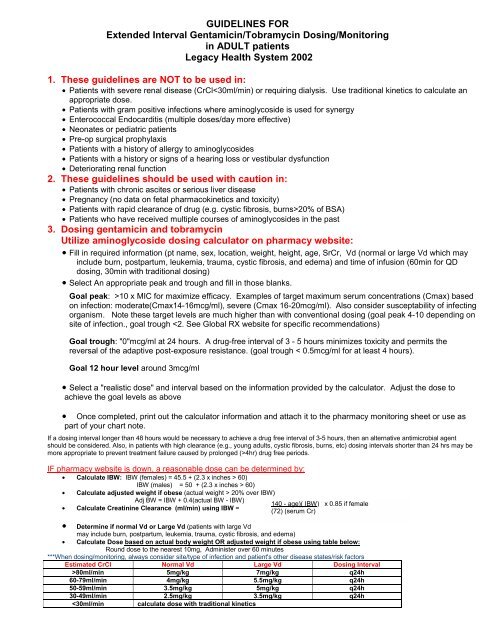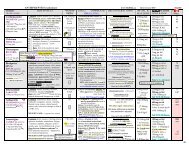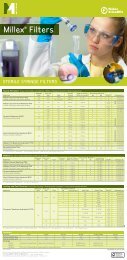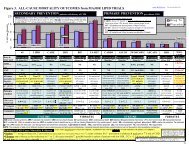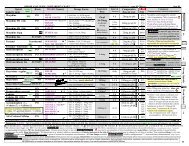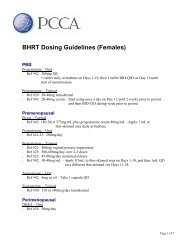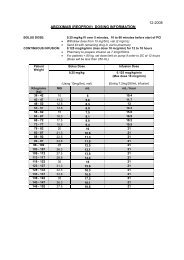GUIDELINES FOR Extended Interval Gentamicin/Tobramycin - DrofRx
GUIDELINES FOR Extended Interval Gentamicin/Tobramycin - DrofRx
GUIDELINES FOR Extended Interval Gentamicin/Tobramycin - DrofRx
You also want an ePaper? Increase the reach of your titles
YUMPU automatically turns print PDFs into web optimized ePapers that Google loves.
<strong>GUIDELINES</strong> <strong>FOR</strong><br />
<strong>Extended</strong> <strong>Interval</strong> <strong>Gentamicin</strong>/<strong>Tobramycin</strong> Dosing/Monitoring<br />
in ADULT patients<br />
Legacy Health System 2002<br />
1. These guidelines are NOT to be used in:<br />
• Patients with severe renal disease (CrCl20% of BSA)<br />
• Patients who have received multiple courses of aminoglycosides in the past<br />
3. Dosing gentamicin and tobramycin<br />
Utilize aminoglycoside dosing calculator on pharmacy website:<br />
• Fill in required information (pt name, sex, location, weight, height, age, SrCr, Vd (normal or large Vd which may<br />
include burn, postpartum, leukemia, trauma, cystic fibrosis, and edema) and time of infusion (60min for QD<br />
dosing, 30min with traditional dosing)<br />
• Select An appropriate peak and trough and fill in those blanks.<br />
Goal peak: >10 x MIC for maximize efficacy. Examples of target maximum serum concentrations (Cmax) based<br />
on infection: moderate(Cmax14-16mcg/ml), severe (Cmax 16-20mcg/ml). Also consider susceptability of infecting<br />
organism. Note these target levels are much higher than with conventional dosing (goal peak 4-10 depending on<br />
site of infection., goal trough 4hr) drug free periods.<br />
IF pharmacy website is down, a reasonable dose can be determined by:<br />
• Calculate IBW: IBW (females) = 45.5 + (2.3 x inches > 60)<br />
IBW (males) = 50 + (2.3 x inches > 60)<br />
• Calculate adjusted weight if obese (actual weight > 20% over IBW)<br />
Adj BW = IBW + 0.4(actual BW - IBW)<br />
• Calculate Creatinine Clearance (ml/min) using IBW =<br />
140 - age)( IBW) x 0.85 if female<br />
(72) (serum Cr)<br />
• Determine if normal Vd or Large Vd (patients with large Vd<br />
may include burn, postpartum, leukemia, trauma, cystic fibrosis, and edema)<br />
• Calculate Dose based on actual body weight OR adjusted weight if obese using table below:<br />
Round dose to the nearest 10mg, Administer over 60 minutes<br />
***When dosing/monitoring, always consider site/type of infection and patient's other disease states/risk factors<br />
Estimated CrCl Normal Vd Large Vd Dosing <strong>Interval</strong><br />
>80ml/min 5mg/kg 7mg/kg q24h<br />
60-79ml/min 4mg/kg 5.5mg/kg q24h<br />
50-59ml/min 3.5mg/kg 5mg/kg q24h<br />
30-49ml/min 2.5mg/kg 3.5mg/kg q24h<br />
4. Aminoglycoside levels:<br />
a. When to order levels:<br />
• Aminoglycoside serum concentration MUST be obtained with first dose if:<br />
o Creatinine Clearance < 50ml/min<br />
o Intensive Care Unit patient (except one time doses)<br />
o Severe infection<br />
o Patient on concomitant nephrotoxic drugs (e.g. amphotericin, cyclosporine, vancomycin)<br />
o Patient at higher risk for acute renal failure (received contrast media in the prior 72 hours, age>65yo,<br />
diabetic, underlying renal dysfunction, received multiple courses of aminoglycoside in the past)<br />
• Must obtain aminoglycoside level later in therapy if:<br />
o Patient maintained on therapy ≥ 5 days<br />
o Renal function changes (SrCr increases by 0.5mg/dl above baseline) Consider DC aminoglycoside in<br />
this patient<br />
o After any dose change that was based on a previous high or low level<br />
o Plan to send home for continued therapy (obtain prior to DC)<br />
• Repeat level at least every 7 days for patients on long term therapy<br />
b. When to draw level:<br />
• Draw one level 12 hours after start of infusion<br />
• Draw two levels if expect patient to exhibit unusual kinetics (fast clearance, large Vd) e.g.at 6 and 13<br />
hours in order to perform kinetic calculations<br />
c. Interpreting levels<br />
• Specifically timed drug levels (e.g. 12hr ) should be plotted on the dosing nomogram graph (goal at<br />
12hours ( ≤ 3mg/L). If level draw right at 12hr, use table below. Levels draw at other times can be<br />
interpreted based on the nomogram graph. This table/graph requires the interval be lengthened for<br />
high levels. Alternatively, the dose could be decreased to allow for a drug free interval.<br />
If 12hr level (1hr infusion + 11hr) is < 3 continue q24h dosing<br />
If 12hr level is 3 - 5 change to q36h dosing<br />
If 12hr level is 5 - 7 change to q48h dosing<br />
If 12hr level is > 7 DC protocol and switch to traditional dosing<br />
• Any level drawn ≤4 hours prior to the next dose should be near zero (5 days (dizziness, nausea, tinnitis, sense of fullness in<br />
the ears, hearing loss). Notify physician to consider DC of the aminoglycoside should these symptoms occur.<br />
i. What is the projected course of therapy (long term)?<br />
6. Required documentation/communication:<br />
a. Initiation and completion of pharmacokinetic monitoring form
. Daily patient chart note<br />
c. Daily clindoc entry in echart<br />
d. Communication between LIS/inpatient hospital if patient being transferred to their service. FAX copy of<br />
monitoring form with pertinent chart notes and patient information to facilitate adequate transition (fax# 225-<br />
6130). In addition, call LIS RPh if complicated patient or specific information needs to be communicated (225-<br />
6100)<br />
Background Information<br />
1. The rational for the pulse dosing of aminoglycosides is rooted in the following observations:<br />
a. Aminoglycosides exhibit a significant post-antibiotic effect (PAE) against aerobic GNB both in vitro and in<br />
vivo. The PAE refers to the continued suppression of bacterial growth despite the decline of the antimicrobial<br />
concentration to zero. The duration of this effect (2 - 8 hrs) depends on several factors, chief among them is the<br />
height of the preceding aminoglycoside peak . The PAE phenomenon suggests that the aminoglycoside serum<br />
level may be allowed to fall below the MIC of the pathogen without compromising antimicrobial efficacy. Animal<br />
studies suggest that the PAE duration may be shortened by neutropenia. In addition, in vitro studies suggest<br />
that the aminoglycoside PAE is extended by the addition of a ß-lactam antibiotic.<br />
b. The bactericidal action of aminoglycosides is concentration dependent, i.e., the higher the peak/MIC ratio<br />
the higher the kill rate). The multiple daily dosing regimen usually results in relatively low peak/MIC ratios (10). Ideally, the peak-to-MIC ratio should be >10.(MIC


